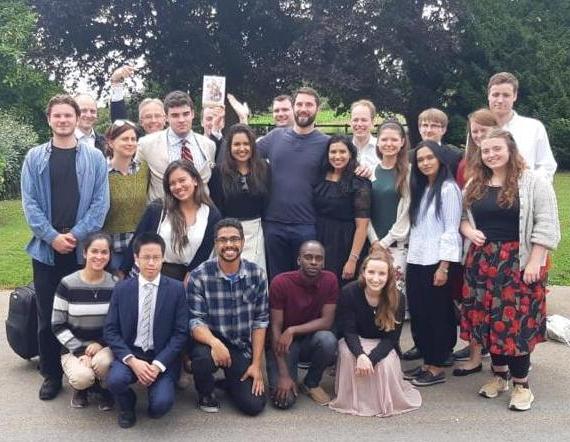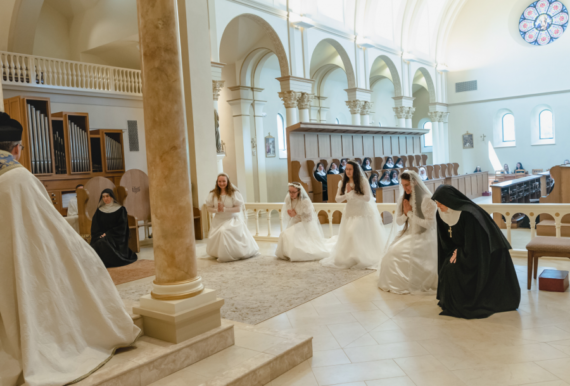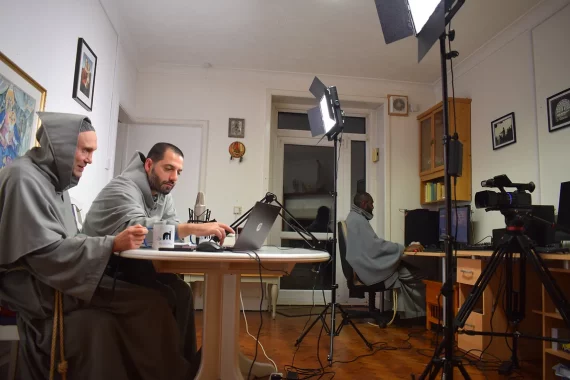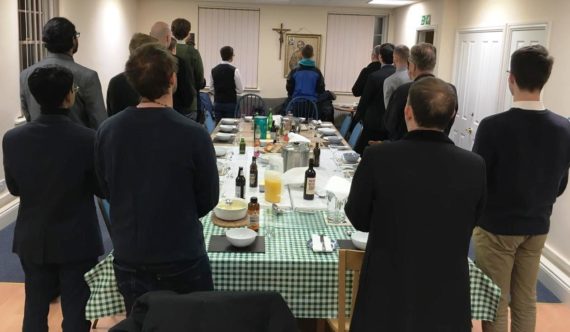Why Young People Choose Consecrated Celibacy
Scroll down to two videos on this topic by Fr de Malleray
By Fr Armand de Malleray, FSSP, Chaplain to the Juventutem London Youth Group (this article first appearead in Dowry Mag No51, Autumn 2021)
Who is left? Looking at the group picture of about twenty young Catholics, my finger points at one face after another while next to me a young friend comments: “Gone. She’s also gone. He’s gone as well. They’re gone too.” The picture was taken on retreat in Berkshire in July 2019, the summer before Covid began. Since then, a dozen of them have disappeared… Where did all these young people go? Are they sick with a virus in some hospital ward? Are they in gaol? Are they dead?

Under arch-tyrant Joseph Stalin, official group pictures underwent regular updating as more and more collaborators in the entourage of the suspicious Communist leader were executed. Long before digital graphic design, technicians in Soviet communication had learnt to delete faces and replace them by credible clouds or trees. The young adults on our group picture were spared such a fate. Their youthful features can still be identified on that photo among their friends still in the world, whether married or single. Meeting them in the flesh, though, has become impossible. Why? Because they have left the world.
Twelve of them have embraced the state of consecrated life. They are now scattered in convents, monasteries, and seminaries. How extraordinary! Could there have been less favourable a time to make such an absolute decision? Remember, the whole world was gripped by a virus seemingly lethal. No one could travel anywhere, least of all to visit some abbey overseas. One could not even enter a church to pray and ask God for the grace of discernment, as all places of worship were locked up. Spiritual directors and confessors were little able to provide adequate guidance, confined as they were in their presbyteries and chaplaincies. If anything, they might have suggested to postpone the choice of consecrated celibacy until the end of Covid, whenever it may come. And yet, against formidable odds, a dozen young adults in London and across Britain heard a call, assessed it, and bravely answered it. They had little more in common, it seemed, than being in their twenties and having come across the traditional Latin Mass. They attended it wherever permitted and met at the monthly Juventutem London gathering.

They all joined communities where the same traditional liturgy is offered in full communion with the Church. P. is a Redemptorist in Papa Stronsay, Scotland. R. is a parish nun in Minneapolis, America. V. is a Eucharistic Adorer in Naples, Italy. X. is a novice at the Marian Franciscans’ in Gosport, England. D. and L. are seminarians in Tuscany; while D. and H. from Cheshire, C. from Ulster, T. and M. from London and F. from South Wales study for the priesthood in Bavaria and in America. G, from Wales is on pastoral stage in England. E. is a Carmelite in Birkenhead, England. Y. from Wales, and S. are Benedictine nuns in Gower, America. F. is a Franciscan Nun of the Immaculate in San Giovanni Rotundo, Italy. In addition, S. just announced that he will begin with the Gosport Franciscans by Easter. S. is actively discerning with the Naples Adorer Sisters. F. started at the Lanherne Carmel and T. will begin with the Redemptorists in Scotland around Easter.

More have joined some communities a few years before Covid, like at Silverstream Priory in Ireland, or without previous involvement with Juventutem, like T. who is trying his vocation with a Thomistic clerical community in America. A few more, at least among those known to me, are in communities where the traditional Latin Mass is offered regularly, if not exclusively, like the various Oratories in England and Wales, the Norbertines in Chelmsford and the Order of Malta in which an erstwhile parishioner of mine just became a solemnly professed religious. Young people once connected with Juventutem or with traditional Mass centres have also joined Novus Ordo communities with use of Latin, like H. from Edinburgh at St Cecilia’s on the Isle of Wight, and T. from Basingstoke now at Douai Abbey in Berkshire. I had indication of more, not personally known to me, who have joined other communities.

If focusing on those whose vocation lead them to traditional communities, one will find that the proportion is very high, since these young people are much fewer than those attending Novus Ordo parishes across the dioceses. In addition, their chances to proceed with discernment are thin, as spiritual directors actively supportive of the traditional Latin Mass are not many. Even when benefitting from sympathetic direction, these young people have very few places they might join in Great Britain, and not many more abroad, should Covid regulations allow them to travel. Finally, all the traditional communities listed above are young. The Priestly Fraternity of Saint Peter, by far the largest (with 530 members on four continents) and the oldest, was founded only thirty three years ago. Most others are between one and fifteen years old (like the Benedictines Nuns of the Immaculate in Northern Italy), or if older, have adopted the traditional liturgy in the past year or so.
So many uncertainties combined could have deterred our young people. And yet, by the grace of God, they did not. How and why so many, proportionately, have answered the call in the past few years, is a mystery to me. Since my first appointment in England twenty years ago, time and again through retreats, articles and spiritual direction I have urged the importance and beauty of consecrated life. While the response has been rewarding as regards priestly vocations, it had remained practically null for religious life, especially for religious nuns. What a blessing that divine Providence choses to reach out to so many precisely now, when circumstances are most adverse. No doubt this is an answer to the prayers and sacrifices of many, lay and consecrated alike, alive and dead. I know of families who offer up their evening rosary for such a crucial intention. I am sure that religious in dwindling communities also intercede for the torch to be passed on. Nor should our British saints and martyrs in heaven be forgotten: so many died for the Faith in gruesome torments. Even better than we, they must see how urgently England and the world need a revival of religious life. They must be praying hard to the Master of Harvest to send many, many generous and sacrificial souls to reclaim the land.

Admittedly, these numbers are still small, since what are twenty or even forty young religious compared with the large and well-established monasteries, convents and friaries which have closed over the past fifty years? In addition, the new communities they join are just this: new, with all the risks inherent to a recent beginning, such as little experience, limited resources and very few powerful friends either in the Church hierarchy or in secular society. And yet, it would not be the first time that the Holy Ghost selected instruments left out of the most professionally designed pastoral plans.This November fifty young men and women attended a day of conferences and prayer on the vocation to consecrated life organised by Juventutem London. Later this same month, fourteen men between 18 and 29 years of age attended a weekend of vocational discernment at St Mary’s Shrine in Warrington. In addition, not a few of these young people are converts or reverts who found their way to Holy Church together with their parents and siblings. This shows that God’s invitation reaches every generation, not only the young, as evidenced in the increased attendance at traditional Mass centres across the country.

We, English Catholics in our bleak or anxious 2020s, are given the grace of witnessing what could be a crucially promising revival. Can there be any doubt that our Isles, across which monasticism grew of old and bore such glorious fruit, from Rievaulx and Jarrow to Glastonbury, and from Iona, Fountains and Bury to Westminster, await a new wave of gentle conquerors, armed not with arrows and chains, but with crosses and beads?
How can one help foster such a timely revival, you may wonder? The Catechism of the Catholic Church (#2233) teaches that, “Parents should welcome and respect with joy and thanksgiving the Lord’s call to one of their children to follow him in virginity for the sake of the Kingdom in the consecrated life or in priestly ministry.” Our readers already settled in a state of life may pray for consecrated vocations to be granted among their own children, nephews and nieces, godsons and goddaughters and young friends. They can also join this 8,000-strong international prayer network for vocations: fssp.org.uk/about-the-confraternity/. Last autumn (2021), a record number of 49 seminarians were admitted in the First Year with the Priestly Fraternity of St Peter (more had applied but we lacked space). As to you, dear young readers, please see whether this balanced portrait of would-be religious offered us by the meek and gentle St Francis de Sales might perhaps strike a chord in your heart:

“…religious orders have been called hospitals in every age and religious are known by a Greek word which means healers because they are in a hospital to heal one another like the lepers of Saint Bridget (n19) (v36). We need not expect that those who enter religious life will be immediately perfect; it is enough for them to tend to perfection, and to embrace the means for growing in perfection. Our community, no more than any other religious community, is not a group of perfect women but rather a group of women who are aiming at and tending toward perfection. It is a school where we come to learn about the means that we must use to become perfect. And in order to do this, it is necessary to have this firm and constant will such as I spoke of, to embrace all the means of growing in perfection that are proper to the vocation in which one is called.
Therefore, it is not the tearful, sorrowfilled and sighing person who is the best one called; nor those who are consumed mostly with the cross, nor those who will not move from the chapel, nor those who are always in the hospital [i.e. to tend sick patients], nor even those who begin with a burst of fervour. We must not pay any attention to the tears of the weepers, nor listen to the sighs of the sighers, nor look for bearing and deportment to find those who are truly called. But we should look for those who have a good, strong and constant resolve to be healed and who because of that resolve work faithfully to recover their spiritual health.” □
(Above quote cf Conference Seventh, in www.oblates.org/spiritual-conferences/.)
Why young people choose consecrated celibacy:
Despite Covid travel restrictions and churches locked up, more young adults have entered traditional convents, seminaries and monasteries over the past few years. Fr de Malleray explains what consecrated celibacy entails and why such a demanding ideal appeals to the younger generation. Juventutem London (UK), 13 November 2021.
Click on links below to launch videos:
Juventutem London – Day of Recollection Nov 21 – Part 1
Juventutem London – Day of Recollection Nov 21 – Part 2
Watch our short video Called to become a priest…
Re-read earlier articles and homilies on Vocations:
Light the Beacons! (2015)

Are You the Fiftieth? (2010)
